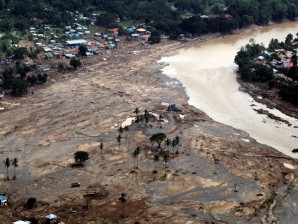Tropical Storm “Sendong” that left a death toll of more than 1,260 and P1.3-billion in damage to agriculture and property in Mindanao cannot be definitively attributed to climate change but rather was an extreme weather event that could become more likely and frequent with climate change.
The Manila Observatory made this conclusion in its preliminary analysis of Sendong whose heavy rains caused the massive landslides and flashfloods that devastated the cities of Cagayan de Oro and Iligan last December 16 and 17.
The research institution, quoting the Joint Typhoon Warning Center (JTWC), said Sendong had a one-minute average maximum wind speed of 100 kilometers per hour and was a weak tropical cyclone.
“Technically, then, according to current wind-based typhoon warnings, Sendong was a ‘weak’ storm. But similar to Tropical storms Ondoy and Pepeng, the rainfall amount associated with Sendong was extreme and resulted in severe flooding,” it said.
The Manila Observatory said Sendong was an “extreme weather event” in terms of one-day total accumulated rainfall. The storm brought rainfall that was much higher than normal.
It said 180 millimeters of rain was recorded in the affected area in just one day, citing data from the Philippine Atmospheric Geophysical and Astronomical Services Administration’s (Pagasa) weather station in Lumbia, Cagayan de Oro.
This was higher than the monthly average of 117mm of rainfall and the highest one-day rainfall amount recorded in the Lumbia station from 1977 to 2005. The maximum recorded rainfall in the station was 142mm in 1999, it said.
“The scientific consensus is that extreme weather events are going to be more likely and frequent with climate change. What Sendong has shown us is how serious and disastrous the consequences are of extreme rainfall events, especially in the light of exposure and vulnerability dynamics,” the Manila Observatory said in its website.
The agency said it would be “difficult to attribute one extreme event to climate change and we cannot make a definite conclusion about whether Sendong is part of climate change.”
The Manila Observatory report was prepared by Faye Cruz, Genie Lorenzo, Julie Dado, Raul Dayawon, Emil Gozo, Toni Loyzaga, Celine Vicente and Gemma Narisma.
The Manila Observatory said that tropical cyclones cross Mindanao less frequently than Luzon and Visayas. In the past 15 years, only six typhoons crossed Mindanao, while an average of one typhoon a year made landfall in the region between 1883 and 1900, it noted.
